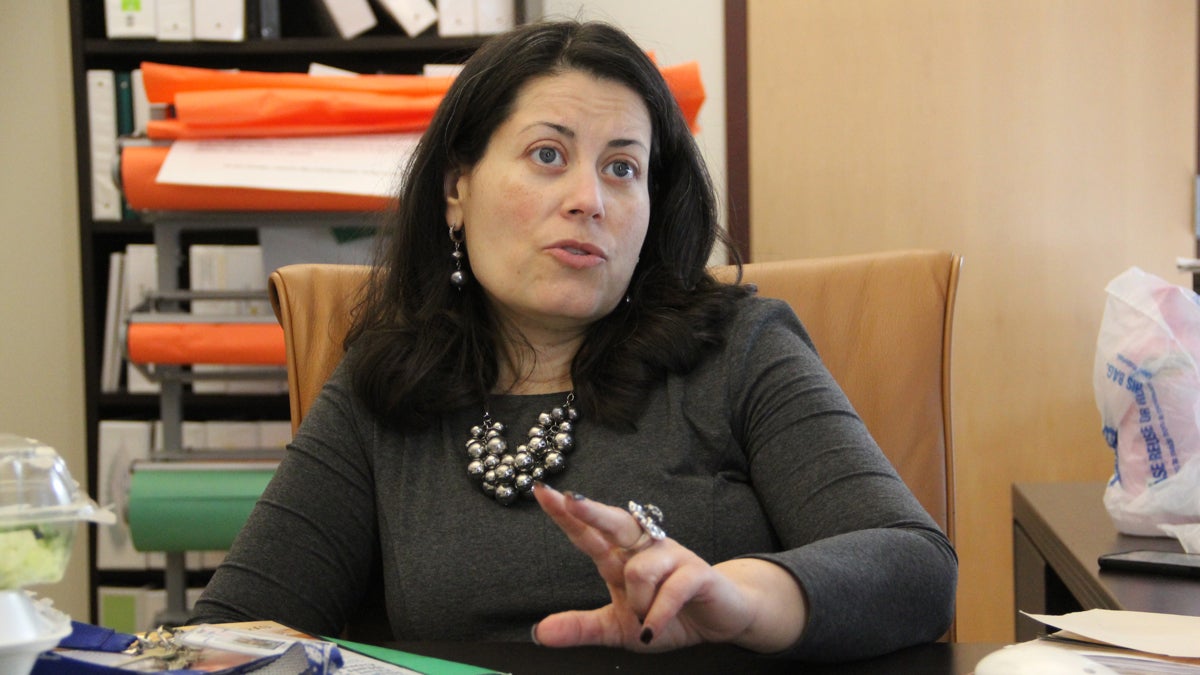Firm providing substitutes in Philly schools improves dismal performance
Listen
Kensington CAPA Principal Lisette Agosto says Source4Teachers has gotten better through the school year at providing suitable substitute teachers. (Emma Lee/WHYY)
The private company the School District of Philadelphia hired to handle substitute teaching services has continued to make improvements, but still severely misses expectations.
Last week, NewsWorks published a story based on Right-to-Know data that detailed the distressing rates at which Source4Teachers has staffed substitutes in most of the district’s 200-plus schools.
In response, District officials rushed to provide updated data showing that the Cherry Hill-based firm has made some significant strides.
The original story focused on data from Sept. 8 through Dec. 23 – the beginning of the school year through winter break.
In that time, Source4Teachers filled vacancies only 10 percent of the time or less at 62 district schools.
When substitutes don’t show, teachers at the affected school scramble to fill-in by sacrificing their preparation periods.
The updated data – which extends to Feb. 19 – shows that Source4Teachers provided substitutes for the majority of the district’s schools less than half the time they were needed.
But there is marked improvement.
The number of schools with percentage fill-rates at 10 percent or less has been cut in half compared with the prior data set.
And 51 schools saw fill rates increase 10 percentage points or more.
But Source4Teachers performance at some schools has trended in the wrong direction. In 30 schools, rates worsened since the prior data set – two schools saw drops of 10 percentage points or more.
Daily Substitute Teacher Fill RatesCreate your own infographics
The district had hoped that Source4Teachers would find better ways to attract substitutes to its most impoverished schools, which has long been a problem.
But that hasn’t happened.
As in the first data set, the numbers show that schools with higher levels of student poverty have a harder time getting substitutes.
Only two schools in the top 20 for percentage fill rate have an economically disadvantaged population that exceeds the district average of 87 percent. Those are Overbrook High School and Catherine Annex.
How Fill Rates Correlate with Student Poverty
At Kensington CAPA, where the student population is 100 percent economically disadvantaged, principal Lisette Agosto said the substitute situation has recently improved greatly.
“It’s gotten better,” she said. “I have to say, it has gotten better.”
The most recent data shows that Source4Teachers is filling vacancies at KCAPA 44 percent of the time – a 17 point jump from the prior data.
At schools across the city, the daily substitute problem has been severely compounded by the slew of openings and long-term vacancies in district schools.
In the first five months of the school year, Source4Teachers was responsible for filling long-term vacancies. As of late January, the district took that responsibility back, but officials say it’s proved very challenging to attract qualified candidates.
The data in the charts above account for fill-rates for both daily and long-term absences. Long-term vacancy fill-rates are only accounted here from 9/8/15 to 1/24/15 – the period for which Source4Teachers was responsible.
All these staffing difficulties have added to woes in many schools – causing educators to sacrifice daily preparation time and sometimes teach courses beyond the scope of their state certifications.
“It’s stressful for me because I’m watching my staff stress out, which creates more vacancies, right? Creates more absences. So it’s like this domino effect,” said Agosto.
Things at KCAPA started to really get better as most of its long-term vacancies were filled, which happened while the private firm was still in charge.
To Agosto, though, the low fill rates were not the most troubling aspect of Source4Teachers performance.
Even when Source4Teachers subs actually came, in the beginning of the year, Agosto said they were not up to quality standards.
“It was potluck what you were going to get, and it wasn’t such a good experience,” she said.
It got to the point where Agosto preferred covering a vacancy internally rather than leave her students in the charge of a Source4Teachers substitute.
Quality, though, has also improved, she said.
“Now we have people that were either teachers before, or at least have strong classroom management – somebody who actually wants to teach versus somebody who wants to just come in and get a check. Big difference,” she said. “Now I feel much more comfortable leaving my kids in the classroom with them.”
Agosto said the new system does come with benefits. Principals have more autonomy to decide which subs come to their schools, and the new system gets subs into buildings earlier. When the service was managed by the district, subs could agree to take positions as late as 8:30 am.
District officials have lamented Source4Teachers performance, but have opted not to cancel the contract and revert to the old method, which employed substitutes at higher pay with union protections.
At a City Council hearing Monday, in which the Newsworks’ article was frequently referenced, Superintendent William Hite restated that he would not push to cancel the district’s two-year $34 million deal with the private firm.
“That would further compound our problems, putting schools with extremely low fill-rates at risk of going even lower,” he testified before the education committee. “Although the district-managed rates were better than what we have now, we would not consider those rates to be good … Source4Teachers is improving, although slowly.”
Source4Teachers pledged to deliver a 75 percent system-wide fill-rate on the first day of school, and a 90 percent rate by Jan. 1. After posting extremely paltry rates in the first month of school, Source4Teachers rate peaked last week at 56 percent. On Thursday, it was 49 percent.
The district has levied financial penalties for underperformance, and the private firm – not the district – must also pay teachers extra for covering vacancies during their prep periods.
Hite said the district is tripling its recruitment efforts for the 2016-17 school year and plans to overhire in order to better cover long-term vacancies that arise.
Long-term partner?
Source4Teachers spokesman Owen Murphy regretted the firm’s underperformance, but said the firm hopes to become the district’s “long-time partner.”
“We’re anxious to get to the point where we’re regularly doing better than the district had been doing itself,” said Murphy. “And we feel that’s right around the corner.”
Source4Teachers originally said it needed 5,000 substitutes in its pool to serve the District adequately. Murphy now believes they could get by with 3,000-3,500. The firm currently has 590 subs in the pipeline – 190 of which are non-teaching support staffers.
Source4Teachers is encouraged by the fact that 80 percent of its talent pool regularly accepts open positions.
“We’ve done a good job of hiring the right people,” said Murphy.
One of the biggest challenges for educators this year has been to prevent the disruption caused by Source4Teachers from drastically undermining academics and culture.
At KCAPA, Agosto said she already has evidence of declines on benchmark assessments in classes that have been plagued by a lack of educator stability.
She said she doubts, though, that the state and district performance metrics – which are often used to make high-stakes decisions – will account for these or myriad other hurdles.
“It’s never fair,” she said. “Even in the best of scenarios, it’s never going to be fair.”
WHYY is your source for fact-based, in-depth journalism and information. As a nonprofit organization, we rely on financial support from readers like you. Please give today.





